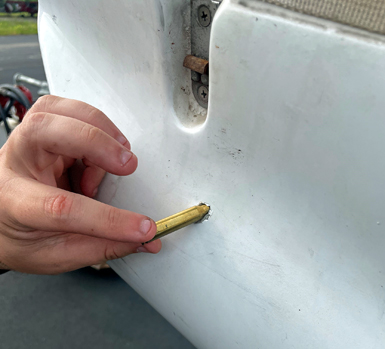A Texas operator escaped injury after his plane was struck by a bullet sometime during a routine corn application. An investigation by the Fannin County Sheriff’s Office remains ongoing.
After spraying a cornfield on the morning of May 7, Dennis Whitlock of Whitlock Air Service in Bonham, Texas, returned to Jones Field Airport to refuel and prepare for his next job. As he was about to fuel up, he noticed a hole on the side of the cowling surrounding the engine of the PA-36-400 Piper Brave. “I said to myself, ‘That looks like a bullet hole,’ and went to look and it,” Whitlock said. Sure enough, a large bullet hole had punctured the cowling (see photos below).

Whitlock opened the cowling to discover that the bullet had ripped through a scat hose that feeds air to the oil cooler and then hit an air intake tube, which deflected the bullet. “Luckily, it didn’t hit the fuel servo on the fuel injection or penetrate the crankcase or any part of the engine itself. It’s kinda like in the movie when the old boy got shot and he pulled out his cell phone or his pocket watch and stopped the bullet,” Whitlock said. “That air intake tube stopped the bullet for me.”
Ultimately, the damage to the plane was relatively minor, but it could have been much worse. If the bullet had taken a slightly different path and penetrated the fuel injection system, it would have shut the airplane down. If it had penetrated the crankcase, the plane would have lost oil and also shut down.
Whitlock never heard any shots fired, but he’s sure the shooting occurred sometime during his morning corn run. He always visually inspects the aircraft before flying, and everything was fine before he ferried to the cornfield 4 miles north of the airport. There were a few houses near the field he sprayed, but he didn’t notice anything unusual.
After discovering the bullet hole, one of Whitlock’s first calls was to his friend and occasional pilot, NAAA President Jim Perrin, who sent NAAA’s shooting-response checklist to him.
Whitlock followed the checklist’s suggestions and began by contacting the local Sheriff’s Office. When a pair of deputies arrived at his hangar and examined the bullet hole, they told Whitlock the bullet was bigger than he had initially assumed. (No slug was recovered.)
“I thought just looking at the hole where it penetrated the outer cowling of the airplane, it was a small caliber, like maybe even a .22. They said, ‘Oh, no, much bigger than that.’ When you look inside the cowling where it impacted the air intake tube on the engine, it is much bigger. It’s like maybe half a dollar or bigger size around.” (See photo below.)

The gravity of the situation started to sink in for Whitlock then. “My first thought was .22, could have just been a kid or anybody just taking a pop shot, and I didn’t think a whole lot about it. Then when they told me it was a larger caliber, that changed my thinking. Then it’s more like, ‘You know, somebody was really trying to do me harm.’”
Whitlock also contacted the FSDO regional operation center in Fort Worth and later spoke with a contact at his local FSDO office about the shooting incident.
On May 12, the Fannin County Sheriff’s Office called Whitlock to inform him that they were making some progress on his case. They didn’t offer more details, but Whitlock thinks they may have identified a person of interest. He has lots of questions that he hopes he’ll get answered eventually.
“I’d love to know the age of the person involved. Were they male, female? What was the caliber of the weapon? There’s a lot of things I’d love to know, but I don’t know if I’ll ever get the opportunity to know it or not.”
Whitlock adds, “In the world I live in, in the spray business, I’m what I call cautiously optimistic. So I’m trying to be cautiously optimistic here.”
NAAA will keep members informed as news develops in the shooting investigation of Whitlock’s ag plane.
Tips for Responding to an Aircraft Shooting
Over and above state laws, it is a federal crime to shoot at aircraft, including unmanned aircraft systems. Penalties can be as severe as 20 years in prison and a $250,000 fine. Even the threat of shooting down an aircraft can result in a five-year prison sentence.
Five years ago, after a series of shootings directed at ag aircraft, NAAA developed a checklist of actions operators and pilots can take in the event someone discharges a firearm at their aircraft. The checklist includes tips on how to report a shooting incident and spread the word to bring the perpetrator to justice. NAAA’s shooting-response checklist is available here to print. It contains the following steps along with NAAA’s advice.
Checklist for Pilots Subjected to Discharge of a Firearm Targeting an Ag Aircraft
- Inform Local Law Enforcement
- Contact the FBI
- Report it to the FAA National Safety Hotline
- Call your Local Flight Standards Office (FSO)
- File a NASA Aviation Safety Report
- Tell Other Pilots
- Notify Local News Media
- Contact Your Insurance Agent if Warranted
In addition to its shooting-response checklist, NAAA is available to offer additional assistance in the event of an ag aircraft shooting. Contact NAAA at (202) 546-5722 for further support.